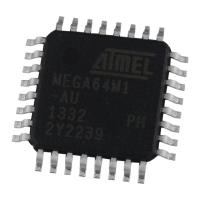180
7647H–AVR–03/12
Atmel ATmega16/32/64/M1/C1
16.5.2.4 Automatic Reply
A reply (data frame) to a remote frame can be automatically sent after reception of the expected
remote frame.
1. Several fields must be initialized before receiving the remote frame:
– Reply valid (RPLV) in a identical flow to the one described in Section 16.5.2.3 “Rx
Data & Remote Frame” on page 179.
2. When a remote frame matches, automatically the RTRTAG and the reply valid bit
(RPLV) are reset. No flag (or interrupt) is set at this time. Since the CAN data buffer has
not been used by the incoming remote frame, the MOb is then ready to be in transmit
mode without any more setting. The IDT, the IDE, the other tags and the DLC of the
received remote frame are used for the reply.
3. When the transmission of the reply is completed the TXOK flag is set (interrupt).
4. All the parameters and data are available in the MOb until a new initialization.
16.5.2.5 Frame Buffer Receive Mode
This mode is useful to receive multi frames. The priority between MObs offers a management for
these incoming frames. One set MObs (including non-consecutive MObs) is created when the
MObs are set in this mode. Due to the mode setting, only one set is possible. A frame buffer
completed flag (or interrupt) - BXOK - will rise only when all the MObs of the set will have
received their dedicated CAN frame.
1. MObs in frame buffer receive mode need to be initialized as MObs in standard receive mode.
2. The MObs are ready to receive data (or a remote) frames when their respective config-
urations are set (CONMOB).
3. When a frame identifier is received on CAN network, the CAN channel scans all the
MObs in receive mode, tries to find the MOb having the highest priority which is
matching.
4. On a hit, the IDT, the IDE and the DLC of the matched MOb are updated from the
incoming (frame) values.
5. Once the reception is completed, the data bytes of the received message are stored (not
for remote frame) in the data buffer of the matched MOb and the RXOK flag is set
(interrupt).
6. When the reception in the last MOb of the set is completed, the frame buffer completed
BXOK flag is set (interrupt). BXOK flag can be cleared only if all CONMOB fields of the
set have been re-written before.
7. All the parameters and data are available in the MObs until a new initialization.
16.5.3 Acceptance Filter
Upon a reception hit (i.e., a good comparison between the I
D + RTR + RBn + IDE
received and an
IDT+ RTRTAG + RBnTAG + IDE
specified while taking the comparison mask into account) the
IDT
+ RTRTAG + RBnTAG + IDE
received are updated in the MOb (written over the registers).

